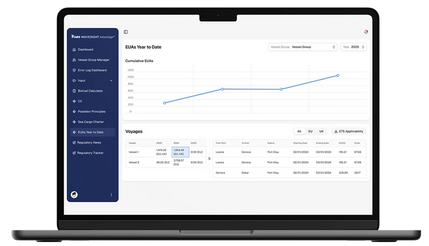Unlocking Capital from Goods on the Move Through In-Transit Freight Financing
Recent history demonstrates just how unpredictable global supply chains can be, where delays, disruptions and prolonged transit times create substantial capital constraints for businesses. In-transit financing can address these challenges by converting goods enroute into liquidity that enables businesses to sustain operations and pursue growth without interruption.
By combining negotiable bills of lading, structured credit arrangements and seasoned lending partners, businesses can turn shipments into strategic financial assets that scale with confidence and strengthen resilience against supply chain uncertainties. In today’s interconnected and often unpredictable global trade environment, in-transit financing is more than a source of capital – it is a strategic tool businesses can use to sustain operations, navigate risk and build long-term resilience.
Converting Goods in Motion into Working Capital
Global supply chains are longer, more complex and increasingly unpredictable. For businesses managing shipments that might be in transit for weeks, waiting for inventory to arrive before accessing capital can create significant cash flow pressures. Traditional financing structures through lines of credit, loans or receivables often fail to align with transportation and logistics’ operational realities. In-transit freight finance can address this gap and enable businesses to leverage inventories while enroute, thereby preserving liquidity and supporting uninterrupted operations from origin to destination.
What Is In-Transit Freight Finance?
In-transit freight finance is a short-term working capital solution that allows companies to draw on the value of inventory before reaching a consignee, warehouse or distribution center. By converting shipments that are in-transit into financial assets, businesses can bridge the period between the purchase and delivery of those cargoes. This financing tool is particularly relevant for enterprises that have long lead times, high-volume imports or demand-driven inventory cycles.
Unlocking liquidity that is tied to goods that are in-transit, this financing tool allows businesses to pay their suppliers, manage costs associate with duties and tariffs, and maintain operational continuity without waiting for the cargo to arrive at their intended destination. In this way, in-transit freight financing transforms inventory from a cash-intensive asset into a resource that supports working capital needs of the business.
How In-Transit Financing Works
In-transit financing is structured to move in step with the supply chain. Once goods depart from a supplier or a port, a financing partner assesses the shipment value in order to establish a borrowing base. In some cases, the base can be combined with accounts receivable to create a flexible line of credit. Funding will be extended upfront to give the shipper the ability to cover operational costs or manage concurrent shipments while the goods remain in transit. Repayment of the extended credit is timed with the delivery or sale of the goods, which minimizes operational strain while protecting the lender’s collateral.
Important to this process is a negotiable master bill of lading (“MBL”). When issued “To the Order of” a lender or a designated agent, the MBL operates as a negotiable instrument that grants enforceable rights to the cargo. By contrast, house bills of lading (“HBLs”) are often non-negotiable and issued to the shipper, which limits their utility to secure in-transit financing. Proper coordination of service providers’ HBLs and MBLs, combined with tripartite agreements involving carriers, forwarders, warehouses and customs brokers, ensures the in-transit lender’s rights are recognized while maintaining the uninterrupted flow of goods.
The Role of Specialty Lenders
Businesses that produce high-value goods or a high-volume of shipments across complex supply chains stand to benefit. Sectors such as retail, consumer goods, electronics and the automotive industry, as well as companies navigating seasonal stock builds, just-in-time inventory models or unexpected delays, can use in-transit financing to preserve liquidity and maintain operational momentum. Partnering with a specialty lender is a critical component of an effective in-transit financing strategy. Experienced lenders structure solutions that account for multi-modal transportation, fluctuating delivery schedules and cross-border regulatory obligations. These lenders can deliver scalable funding, responsive approval processes and flexible repayment terms, while preserving a business’ existing credit structure.
Navigating Supply Chain Disruptions
Recent supply chain disruptions stress the practical importance of in-transit financing. For example, geopolitical tensions in the Middle East and Houthi attacks on vessels in the Red Sea have forced the steamship lines to reroute around Africa, which have substantially increased transit times. Similarly, additional pressures due to port congestion, rising cargo volumes, severe weather, climate events, labor shortages, slow steaming rules and container scarcity create delays that immobilize working capital.
In-transit financing addresses these challenges by transforming goods that are already in-transit into liquid assets, enabling companies to sustain operations despite market uncertainties. By freeing up cash tied in shipments and inventory, businesses can maintain liquidity and reduce balance-sheet strain to support supply chain resilience through extended payment terms and improved cash-flow timing. This approach is especially important as businesses navigate seasonal slowdowns and factors affecting global trade to enhance financial agility without increasing debt.
Key Advantages
In-transit financing provides a number of operational and financial benefits:
- Improved Liquidity: Access capital tied to inventory before it reaches its final destination.
- Supply Chain Continuity: Maintain operations despite extended lead times or supply chain delays.
- Operational Alignment: Funding can track actual shipment and inventory cycles.
- Existing Credit: Financing works alongside existing credit facilities.
- Quick Access to Capital: Approvals are based on the value of the goods in-transit.
- Global Trade Support: Businesses can manage international shipments that have longer transit windows.
 Phil Nester is a Senior Managing Associate with the Transportation & Logistics Practice Group. He may be reached by telephone at 1-216-363-1640 or by e-mail at jpnester@beneschlaw.com.
Phil Nester is a Senior Managing Associate with the Transportation & Logistics Practice Group. He may be reached by telephone at 1-216-363-1640 or by e-mail at jpnester@beneschlaw.com.













